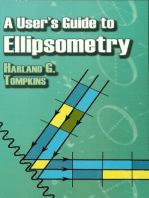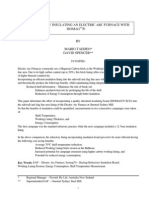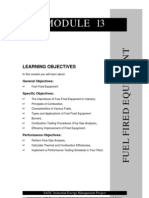EAT LOW Asics: Heat Flows From Hot To Cold
EAT LOW Asics: Heat Flows From Hot To Cold
Uploaded by
chandirandelhiCopyright:
Available Formats
EAT LOW Asics: Heat Flows From Hot To Cold
EAT LOW Asics: Heat Flows From Hot To Cold
Uploaded by
chandirandelhiOriginal Title
Copyright
Available Formats
Share this document
Did you find this document useful?
Is this content inappropriate?
Copyright:
Available Formats
EAT LOW Asics: Heat Flows From Hot To Cold
EAT LOW Asics: Heat Flows From Hot To Cold
Uploaded by
chandirandelhiCopyright:
Available Formats
HEAT FLOW BASICS
Heat flows from hot to cold. Always. Within air conditioners and heat pumps this process is manipulated to make it appear that the opposite occurs. Temperature a measure of thermal energy, units of Kelvin (K) or Celsius (C) Conductivity a material property, heat flow per unit area per unit thickness per unit temperature, symbol k (W/m K) Conductance a property of a material layer, heat flow per unit area and temperature, symbol C (W/m2 K) = conductivity k / thickness l (in meters) Resistance a property of a material layer or wall measured from surface to surface, equals 1/C , symbol RSI (m2 K /W) Imperial value R (ft 2Fr/Btu) = 5.678 RSI Overall heat transfer coefficient a property of an enclosure assembly, basically the thermal conductance of an assembly, heat flow per unit area and temperature, symbol U, U = 1/Rtotal , units W/m2 K. Example: Given that the thermal conductivity of Type 4 extruded polystyrene (for example, Styrofoam SM) is 0.029 W/mK, find the conductance and resistance of a layer 50 mm thick in both imperial and metric units. Answer: Conductance = conductivity k / thickness l (in meters). 50 mm = 0.050 m so C = 0.029 / 0.050 = 0.58 W / m2K this means, for example, that a one square meter panel of 50 mm thick Styrofoam SM will allow 0.58 watts of energy to pass through it under a one degree Kelvin (or Celsius) temperature change. Resistance, RSI = 1 / conductance, so C = 1 / 0.58 = 1.724 m2K / W Hence, a layer of SM would have a thermal resistance of RSI 1.724. If one were to look in a building supply store, a sheet of 2 SM would be stamped with RSI1.76, since 2 sheets are slightly thicker than 50 mm. By the way, a layer of 100 mm would have a thermal resistance of RSI3.45, eg twice the thickness, twice the resistance (this does not work with conductance). The thermal resistance in imperial R-value would be: Imperial value R (ft 2Fr/Btu) = 5.678 RSI Rimp = 5.678 * 1.724 = Rimp9.8 Again, a full 2 thick sheet would have a slightly higher R-value of R10. Thus, one often speaks of an insulation value of R5 per inch. Four inches, R20 for this layer, 1.5, R7.5 for the layer. Most building enclosures include more than just materials they also include air spaces, which are insulating. The heat transfer from the air next to the enclosure to the surface of the enclosure is also not perfect. Hence, one needs to calculate the impact of this effect. These complications are discussed next.
J. F. Straube
Heat Flow Basics
SURFACE FILMS
To account for both the radiative and convective heat transfer modes at the exterior and interior surfaces of building components, the radiative and convective heat transfer coefficients are used in the form of an equivalent conductance or, alternatively, equivalent resistances. These equivalent coefficients are termed surface film coefficients. It is important to recognize that a surface film does not exist in reality. The term film is used simply so that a layer (of indefinite thickness) can be added to a typical conductive heat flow analysis. The resistance to heat flow at a surface is small relative to the heat flow resistance of most modern wall assemblies and therefore need not be accurately estimated for most purposes. Poorly insulated walls and windows have a lower overall thermal resistance and thus surface effects are more important. Hence, a more precise calculation of surface films is justified for these types of enclosures. The overall equivalent surface conductances, ho, or resistance in Table 1 can be used in to find heat flow without further modification. Again, note that surface films are fictitious: they do not physically exist, or have thickness. Surface Position
Still Air (e.g. indoors)
Flow Direction Upward Downward Horizontal
Resistance RSI [m K/W]? 0.11 0.16 0.12
2
Conductance [W/m2 K]? 9.3 6.1 8.3
Horizontal (i.e. ceilings and floors) Vertical (i.e. walls)
Moving Air (e.g. outdoors)
Stormy 6.7 m/s (winter) any Breeze 3.4 m/s (summer) any Average conditions any
0.03 0.04 0.06
34 23 17
Table 1: Equivelant Total Surface Film Conductances (ho)
PLANE AIR SPACES
Plane air spaces are commonly used in building assemblies. Heat is transferred across air spaces by a combination of conduction through still air, convection flows, and by net radiation from the warm side to the cold. The modes of heat transfer vary in importance depending on: the emissivities of the surfaces, the thickness of the air space, and the absolute and relative temperatures of the two surfaces. The heat flow across a plane air space can be found with a reasonable degree of accuracy by using detailed correlations of convection and radiation. However, a high degree of accuracy is rarely necessary or justified in light of the many poorly known variables (e.g. variable cavity widths, blocked cavities, etc.) and the relatively small influence that the airspace has on the thermal resistance of modern enclosure assemblies. Simplified values for most practically encountered situations are presented in Table 2. The values in Table 2 are also given in terms of resistances so that they can be directly used in the heat flow equation.
J. F. Straube 2000-2003
UW Building Science
Heat Flow Basics
radiation T1 ?1 convection T2 ?2
conduction s
Heat Transfer Across Plane Airspaces
Situation (non reflective surfaces) Heat Flow Down (20-100 mm) Heat Flow Across (20-100 mm) Heat Flow Up (20-100 mm)
RSI Value 0.18 0.17 0.15
Conductance 5.5 5.9 6.5
Table 2: Thermal Resistance for non-reflective Enclosed Airspaces (W/m2K) In many practical situations an air space is either intentionally or accidentally vented. Air flow through an air space can change the heat flow characteristics, although significant flows are required to modify the equivalent conductances listed above. In most cases, the effect of vented can be ignored, and only in extreme cases does in need to be accounted for. Extreme cases includes highly ventilated attics (at least 1% venting area) and wall panels with at least 2% vent area and cavities over 50 mm in size.
J. F. Straube 2000-2003
UW Building Science
Heat Flow Basics
HOW TO CALCULATE THE "R VALUE" OF AN ENCLOSURE ASSEMBLY
1. 2. 3. 4. Remember: one cannot add conductances, you must add resistances List each material in the wall or roof, its conductivity (k) and its thickness (l) in m Calculate the conductance of each layer (C) using C = k / l . Calculate the thermal resistance of each layer using RSI = 1 / C Sum the individual thermal resistances to get the answer.
Usually the thermal resistance of the air films that exist on both the interior and exterior surfaces of an assembly are added to the wall as virtual layers. This makes our calculations more accurate. Example: Calculate the total thermal resistance (R) and overall heat transfer coefficient (U) of the wall shown below. Use conductivity values from tabulated values.
25 mm airspace 150 mm Concrete 75mm Type4 XPS 90mm clay brick
Inside air =20 ?C
Outside air = -10 ?C
Answer:
Layer Material Conductivity Thickness Conductance Resistance
Interior film note 1 Concrete Type 4 XPS Air space note 2 Brick Exterior film note 1
N.A. 1.8 0.029 N.A. 1.3 N.A.
N.A. 0.150 0.075 25 0.090 N.A.
8.3 12 0.39 N.A. 14.4 34
0.120 0.083 2.56 0.17 0.069 0.029 3.04 0.33
RSI total Overall Heat Transfer, U
Note 1: Table 1. Since the interior and exterior films are fictitious, they do not have a thickness, and so no conductivity. Hence, tables typically contain only conductances or resistances for the layer. These values can be quite variable, but as can be seen, the effect of the value of the film resistance on the total resistance of a wall is small if the wall is a modern insulated assembly. Note 2: Table 2. The flow of heat through an air space is complicated by convection (air flows) and radiation and so tabulated values of conductance are used instead. Like surface films, the values are variable but not important to accuracy in the calculation in most modern walls.
The total resistance is RSI3.04 (or imperial R 17.2), 84%of it provided by the insulation, and heat flow will be 0.33 W/m2 K.
J. F. Straube 2000-2003
UW Building Science
Heat Flow Basics
HOW TO CALCULATE THE STEADY-STATE HEAT FLOW THROUGH AN
ENCLOSURE SYSTEM
Heat flow across an assembly is simply the temperature difference divided by the R-value times the overall heat transfer coefficient. The temperature difference is usually just (tinside toutside). 1. Find the total thermal resistance of the enclosure as described earlier 2. Find the overall heat transfer coefficient U, using U = 1/Rtotal 3. Multiply the temperature difference across the assembly by U, i.e., U*(t inside toutside) Of course if the sun is shining on the wall, the outdoor air temperature is not the correct one to use, (the actual solar heated surface temperature is more accurate, but difficult to find sometimes use the table provided for guidance). The effect of heat storage, or thermal mass, is very important for the wall since heavy mineral-based materials can store a lot of heat. Example: Calculate the amount of heat flow through the wall of the previous example when it -10 C outside with no sun and 20 C inside. Heat flow = U*(t inside toutside) = 0.33 (20 -10) = 0.33 (30) = 10 W/m2
Ans. Heat flow outward would be 10 W/m2. If the wall were exposed to bright sun, the temperature of a very dark surface would be expected to be as much as 48*1 = 48 C above the air temperature (see Table 3 later in this document). For this example, we will assume dark red brick (absorptance =0.85) and thus estimate a surface temperature of about 48 * 0.85 = 40 C above the air temperature. This means: Heat flow = U*(t inside toutside) = 0.33 [20 -(-10+40)] = 0.33 (-10) = -3.33 W/m2
Ans. If the wall were dark red and exposed to bright sunshine, the heat flow would be inward and about 3.33 W/m2.
ASSESSING THE ENERGY LOSS DUE TO AIR LEAKAGE
If cold air leaks out of the building in winter, it is of course replaced with cold/hot air. This cold/hot air must be heated up to make it comfortable. The energy impact of air leakage is significant and must be considered since it is often an important heat loss/gain component of modern buildings. It can be included by calculating an equivalent heat loss coefficient for air leakage. This can be found from: Uair = 0.3 * n * V Where Uair is the heat loss coefficient due to air leakage (W/ C) N is the number of complete air changes per hour ( ACH) V is the total air volume of the building (in m3) Uair can be included in calculations just like Uwall or Uwindow.
J. F. Straube 2000-2003
UW Building Science
Heat Flow Basics
HOW TO CALCULATE THE STEADY-STATE HEAT FLOW THROUGH A BUILDING
SYSTEM
The easiest means of estimating heat flow through an entire building is to 1. Calculate and then list the U-value for each element (wall, roof, window, door) along with the area of that element 2. The product of each elements' area and its U-value is the heat loss coefficient for that enclosure element per unit temperature difference (SI units: W/C) 4. The sum of these products is the overall heat loss coefficient for the building. 5. To find the overall heat loss (or gain) multiply the overall heat loss coefficient for the building by the temperature difference across the assembly. Example: An industrial "big box" store is 8 m high, 32 m long and 64 m wide. The enclosure has a lightweight roof (U=0.36 W/m2/C and ) and precast concrete walls (U=0.4 W/m2/C). The front of the store (which faces west) has a 6 m high by 24 m long glass curtainwall with a U-value of 2.0 W/m2/C. Six loading doors are at the back, each 5 m high and 3.5 m wide with a U-value of 1.0. The building is estimated to leak at 0.5 ACH under normal conditions. Ignoring the effect of the floors, sun, and any other doors, find the heating requirements when it is -10 C. Answer: See the sketch of the building for details of the areas. Air leakage Heat loss: 0.3 n V = 0.3 (0.50) (16384) = 2458 W/C. Enclosure Area U Value Q Heat Loss % Total Component (m2) (W/m2/C) (W/C) Heat Loss Walls Roof Doors Curtain Wall Air Leakage 1287 2048 105 144 0.40 0.36 1.0 2.0 from above 515 737 105 288 2458 4103 W/C 13% 18% 3% 7% 60%
Overall Building Heat Loss Coefficient
Therefore, the total heat loss can be seen to be 4103 W per degree Celsius difference. For an outdoor temperature of -10 C, indoors of 20 C, the difference is 30 C, and total heat loss is 123 kW.
J. F. Straube 2000-2003
UW Building Science
Heat Flow Basics
Building Volume =32x64x8 =16384 Roof Surface Area =32x64 =2048 m2 Curtain Wall Surface Area =24x6 =144 m2 Door Surface Area =6(3.5x5) =105 m2 Wall Surface Area =(64x8)2+(32x8)2-(105+144) =1024+512-105-144 =1287 m2 Building Surface Area =2048+144+105+1287 =3584m2
The relative impact of each building component can also be seen. For this building type, the U-value of the enclosure is unimportant relative to the impact of air leakage. It should also be noted that the amount of lights and equipment and people in the store will typically consume 30 to 50 W/m2 of electricity, all of which is converted to heat. Hence, if we assume an average energy use of 40 W/m2, the interior gains would be: 2048 m2 x 40 W/m2 = 81920 W This energy will offset the losses of 123 kW, but a heating system of some type would be needed to make up the remaining (123-82) = 41 kW.
J. F. Straube 2000-2003
UW Building Science
Heat Flow Basics
SOLAR RADIATION THROUGH WINDOWS
Solar gain through windows exposed to either the direct sun, or reflected sun (reflected off the particles in the sky, creating diffuse radiation or reflected off terrestrial surface, creating beam radiation) can dramatically affect the energy balance of a building. Hence, the energy flows calculated in the previous section must be adjusted by adding the solar gain through windows. This amount of energy can completely dominate the performance of a modern building. The Solar Heat Gain Coefficient (SHGC) is the window property used to rate the amount of energy allowed through windows. The SHGC is the fraction of incident solar radiation that passes through a window and becomes heat inside the building. For example, if the SHGC of a glazing unit is 0.50, and the sun is shining on the window with an intensity of 500 W/m2, 250 W/m2 will enter the building. The lower the SHGC, the less solar heat that the window transmits through and the greater its shading ability. In general, South facing windows in houses designed for passive solar heating (with a roof overhang to shade them in the summer) should have windows with a high SHGC to allow in beneficial solar heat gain in the winter. East or West facing windows that receive large amounts of undesirable sun in mornings and afternoons, and windows in houses in hot climates, should have a low SHGC. Most large commercial buildings should have few losses or gains through the building enclosure (this can be calculated) but windows can dramatically alter this. To calculate the impact of windows on cooling: 1. estimate the solar radiation (from charts and tables) that will be striking each building orientation during the cooling period (it is often the hottest outside when it is sunny) 2. multiply the clear area (not including mullions) of each window system on each orientation by the SHGC of that window. 3. add this energy to the energy calculated for conduction and air leakage gains. To calculate the impact of windows on heating is not as straight forward. The balance can be found for any given situation, but the coldest periods are almost always during the night, when there is no sun. Cold days, however, tend to be sunny. Therefore, simple calculations can not be used to estimate how much a furnace can be reduced in size because of solar gain. What can be calculated easily is the impact of overheating. Many solar buildings have overheating problems because of excessive areas of unshaded glass. To investigate this overheating problem, the outdoor temperature should be assumed to be the average temperature in a cool month (e.g. November or March). The maximum solar energy (usually noon with south facing glass for a solar building) should then be calculated. If the energy gain is much more than the energy loss calculated, the building will over heat. Operable shade and large amounts of ventilation will therefore be required, or the window area should be reduced. The most direct and powerful method of controlling solar gain through windows is through the use of shading and orientation. Good control requires a designer to understand the location of the sun over the day and over different orientations. Shading should be on the EXTERIOR of the glazing unit or it will trap heat in the building. With modern glazings, interior shading should primarily be used to control glare. Exterior operable shades are used through out Europe, and work remarkably well. The SHGC for good exterior shades is in the order of 0.05 to 0.10. The same blinds on the interior will reduce the SHGC by about a third.
J. F. Straube 2000-2003
UW Building Science
Heat Flow Basics
Material
Board / sheet products Plywood OSB Waferboard Hardboard Vegetable Fiberboard Particleboard Particleboard Strawslab Corrugated Metal Deck Finishes Ceramic Tiles Acoustic Tiles - fibreboard Acoustic Tiles - glassfibre Gypsum Board Sand Plaster / Lath Gypsum plaster / Lath Sand :Cement plaster Gypsum plaster w/perlite Gypsum plaster w/sand Carpet Fibrous Underlay Carpet Rubber Underlay Terrazzo Hardwood Flooring Siding / Cladding Hardboard siding Wood Siding - lap Plywood Siding Face Brick - clay Face Brick - concrete Metamorphic Stone Sedimentary Stone Metal vinyl clapboard/V-groove Metal - flush installed Cement Stucco Structural Materials Softwood lumber Hardwood Lumber Cedar Logs and Lumber Concrete Concrete (limestone) Concrete (light) Aerated Concrete Aerated Concrete Carbon Steel Aluminum Cement Mortar Concrete Block 200 mm Lt. Wt. Concrete Block, 200 mm Concrete Block, 100 mm Hollow tile, 100 mm
J. F. Straube 2000-2003
Density (kg/m3) 400 - 600 575 - 725
Conductivity Range (W/m K) 0.08 0.09 0.1 0.105 0.045 0.102 0.17 0.085 - 0.11 - 0.12
Conductance Range (W/m2 K)
270 - 300 590 1000 260 - 350
- 0.07
- 0.11 negligible
800 - 900
1570 720 1680
1 0.065 0.036 0.16 0.71 0.16 - 0.35 0.53 0.22 0.8 2.73 4.42 1.8 0.16
640
2000 2200 2600 - 3000 2200 - 2600
0.094 0.1 - 0.12 0.09 1.3 1.9 2 - 2.8 2.1 - 2.3 40 - 80 0.7 - 1.4 0.1 0.15 0.098 1.4 1.1 0.5 0.12 0.18 40 160 0.8 0.14 0.18 0.12 2.6 1.3 0.7 0.15 0.2 80 200 5.1 2.84 8 5.5 8 0 negligible
1800 510 720 2400 1920 1300 400 600 7680 2800 1800
UW Building Science
Heat Flow Basics Durisol Adobe Clay Straw (function of density) Cement-bonded rice husk Wood fibre and cement Insulations EPS Type 1 EPS Type 2 EXPS Type 3 and 4 Batt Insulation Rigid Mineral Fiber Rigid Fibrous Roof Insulation Rigid Polyurethane Rigid Polyisocyanurate Phenolic Foam (closed cell) Urea Formaldehyde Fibreboard Cellulose Fibre Sawdust Strawbale Corkboard Sprayed Asbestos Vermiculite, exfoliated Perlite, expanded Perlite, expanded Perlite, bonded/expanded Eel Grass batt Jute Resin bonded Peat slab Sheeps Wool, fluffy Roof Materials Built-up Bitumen Roofing Asphalt Shingles Wood Shingles Crushed Stone Thatch-Straw Thatch-Reed Other Materials Fresh Snow Compacted Snow Ice at -1 and -20 C Water at 20 C Earth, dry to damp Sand dry Air, still (conduction only) Glass, soda lime Copper Lead Brass Nickel Rubber 400 - 500 1400 - 1800 600 - 1400 720 1550 16 24 - 32 0.072 - 0.085 0.4 - 0.8 0.15 - 0.5 0.15 0.32 0.039 0.034 0.029 0.036 0.03 0.036 0.024 0.02 0.017 0.031 0.052 0.039 0.05 0.06 0.042 0.05 0.06 0.2 0.07 0.052 0.043 0.065 0.058 0.045 0.17 12.9 6 240 270 190 400 920 1000 1400 - 2000 1400 1.2 2500 1.60 0.07 0.09 0.19 0.43 2.24 0.60 0.80 0.30 0.03 0.80 380 35 120 60 0.2
- 0.048 - 0.04
- 0.024 - 0.02 - 0.032 - 0.046 - 0.08 - 0.075
270 37 - 51 145 - 160 120 - 200 145 64 130 800 320 16 145 - 215 420 240 - 480 50
- 0.07 - 0.26 - 0.08 - 0.049 - 0.101
- 2.45 - 2.00 - 0.80 - 1.00
J. F. Straube 2000-2003
10
UW Building Science
Heat Flow Basics
THERMAL BRIDGES AND OTHER COMPLICATIONS
One-dimensional steady-state heat flow assumptions may not allow for the accurate prediction of space-conditioning energy consumption for three main reasons: 1. Thermal Bridging: structural members (e.g., wood or steel members in light-frame construction and concrete and steel columns/walls in commercial construction) can act as a thermal bridge causing heat flow to short-circuit. Only two- or three-dimensional analysis can predict and quantify this type of heat flow. The use of insulation to break thermal bridges will effectively reduce this type of heat transfer. 2. Thermal Mass: heat flow through building enclosures is not steady-state. Heat stored in the thermal mass of buildings and then released can reduce both heating and cooling requirements. Thermal mass also makes it possible to make more effective use of internal and solar gains. Simple steady-state methods of analysis cannot model these effects. Hour-by-hour computer programs are widely available to aid in the assessment of dynamic effects. 3. Air Leakage: Air leakage through the building enclosure can be a major source of energy loss. Airtight buildings use far less energy. Again, the simple, commonly used, analysis techniques cannot assess the influence of air leakage on the thermal performance of a building system. The loss of energy by air leakage (convection) must be calculated in addition to the loss by conduction through the enclosure. Heat flow deviates from one-dimensional at corners, parapets, intersections between different assemblies, etc. When heat flows at a much higher rate through one part of an assembly than another, the term thermal bridge is used to reflect the fact that the heat has bridged over / around the thermal insulation. Thermal bridges become important when: ? ? they cause cold spots within an assembly that might cause performance (e.g., surface condensation), durability or comfort problems they are either large enough or intense enough (highly conductive) that they affect the total heat loss through the enclosure
Thermal bridging, especially by steel framing, or at the intersection of wall corners with roofs and floors, projecting structural elements like balconies and perimeter slabs often causes cold interior surface temperatures and thus condensation. Attached figures provide a schematic of how temperatures at studs and near corners can cause low surface temperatures. In the case of the steel framing shown, an exterior temperature of 10 C can result in interior surface temperatures of 5 to 10 C at studs, and below freezing at floor to wall corners. All enclosures should be designed to avoid a large number and extreme thermal bridges. The most effective solution, insulating wall sheathings (e.g., rigid foam), are quite useful for blunting thermal bridges and also offer energy saving benefits, wind washing resistance, and improved resistance to exfiltration condensation. Convective cooling, or wind-washing, should also be controlled, especially at corners).
J. F. Straube 2000-2003
11
UW Building Science
Heat Flow Basics
?t t
Warm Indoors Cold Outdoors
Plot of Temperature Through Wall Showing Drop At Surface
Thermal bridging: heat flow
Cold Exterior 10 C
Siding Sheathing Batt + Framing Drywall Corner
Warm Interior +23 C
20 Temp 10 0
Plot of Temperature Along wall Mid-height
J. F. Straube 2000-2003
12
UW Building Science
Heat Flow Basics
Thermal bridging: heat flow
Cold Exterior
Siding Sheathing Batt + Framing Drywall Simple R-value Through Studspace Corner
Clear Wall R-value
Warm Interior
2X6 FRAMED WALL
Window Opening Window Opening
2X4 W/ EXTERIOR INSULATION
Clear Wall R-value = Same as Nominal Drywall Batt + Framing Extruded Insulation Siding Simple R-value Thru Wall
J. F. Straube 2000-2003
13
UW Building Science
Heat Flow Basics
RADIATION-INDUCED EXTERIOR SURFACE TEMPERTAURES
Radiation, either solar heating by the sun or cooling by radiation to the night-sky, can have a very significant influence on the thermal exposure of the building enclosure. Although rarely warranted, detailed procedures can be used to relatively accurately calculate, in terms of energy transfer rates (e.g. W/m2), the effect of solar heating and night-sky cooling on enclosure surface temperatures. It is often convenient to have simple equivalent temperatures that can be entered directly into a standard conductive heat flow analysis. When an equivalent air temperature is used, the temperature is termed the sol-air temperature. This procedure has the drawback that air temperature is no longer realistic and the advantage that surface films play a role in the definition of the temperature. The value for the overall surface film coefficient is often assumed to be 17 W/m2C although this coefficient is quite variable, especially if the surface becomes hot. In fact, under solar-heating, the coefficient is likely to be as much as two times larger. A simple and equally realistic approach is to use approximate surface temperatures. Table 3 is a compilation of the most useful approximate surface temperatures based on calculation (using refined surface heat transfer coefficients) and supported by several years of field measurements.
Situation Thermally Massive Thermally Lightweight
ta - 5 ? ta - 10 ? ta + 35 ? ta + 48 ? ta + 28 ? ta + 40 ? ta - 2 ? ta - 4 ? Notes: t a refers to the ambient air temperature, ? is the surface emmittance, and ? is the solar absorptance. The emmittance is about 0.90 for most materials. The absorptance varies with colour from about 0.3 for white/beige objects to 0.65 for forest green to 0.95 for flat black. Thermally massive refers to walls with a significant amount of thermal storage capacity (e.g. brick veneer or equivelant) outside of a low conductance material (e.g. insulation). Walls with significantly more mass (e.g. multi-wythe brick, rubble) or less insulation (U > 1 W/m2/C) will be less affected. Vinyl, metal and EIFS are lightweight walls; other walls can be interpolated based on heat capacity. All values are for approximately 45 North. The values for walls are likely clear night or sunny day maximums and apply to east/west orientations in summer and south orientations in the winter. Table 3: Approximate Radiation-Induced Surface Temperatures (C)
Roofs: direct sun roof: sun plus reflected / emitted radiation roof exposed to night-sky walls: winter sun walls: summer sun walls exposed to night sky
ta + 42 ? ta + 55 ?
ta + 55 ? ta + 72 ?
J. F. Straube 2000-2003
14
UW Building Science
You might also like
- Gauge Theories of the Strong, Weak, and Electromagnetic Interactions: Second EditionFrom EverandGauge Theories of the Strong, Weak, and Electromagnetic Interactions: Second EditionRating: 4 out of 5 stars4/5 (1)
- Overview of Refractory MaterialsDocument54 pagesOverview of Refractory MaterialsHenrique Alvr100% (5)
- Conduction Cooling For Chassis and Circuit BoardsDocument41 pagesConduction Cooling For Chassis and Circuit BoardsKadir Bozdemir100% (1)
- Instead of the ITER project and the TOKAMAK principle: – a new type of fusion machineFrom EverandInstead of the ITER project and the TOKAMAK principle: – a new type of fusion machineRating: 5 out of 5 stars5/5 (1)
- Introduction to Optical Waveguide Analysis: Solving Maxwell's Equation and the Schrödinger EquationFrom EverandIntroduction to Optical Waveguide Analysis: Solving Maxwell's Equation and the Schrödinger EquationNo ratings yet
- Lectures on the Infrared Structure of Gravity and Gauge TheoryFrom EverandLectures on the Infrared Structure of Gravity and Gauge TheoryNo ratings yet
- Princeton Series in Modern Observational AstronomyFrom EverandPrinceton Series in Modern Observational AstronomyRating: 4 out of 5 stars4/5 (1)
- Graphs and Tables of the Mathieu Functions and Their First DerivativesFrom EverandGraphs and Tables of the Mathieu Functions and Their First DerivativesNo ratings yet
- Matrices, Moments and Quadrature with ApplicationsFrom EverandMatrices, Moments and Quadrature with ApplicationsRating: 5 out of 5 stars5/5 (1)
- Megaphysics Ii;An Explanation of Nature: The Equation of Everything in Terms of Cosmology,Strings and RelativityFrom EverandMegaphysics Ii;An Explanation of Nature: The Equation of Everything in Terms of Cosmology,Strings and RelativityNo ratings yet
- Ordinary Differential Equations and Stability Theory: An IntroductionFrom EverandOrdinary Differential Equations and Stability Theory: An IntroductionNo ratings yet
- Special Functions: An Introduction to the Classical Functions of Mathematical PhysicsFrom EverandSpecial Functions: An Introduction to the Classical Functions of Mathematical PhysicsRating: 5 out of 5 stars5/5 (1)
- Introductory Applications of Partial Differential Equations: With Emphasis on Wave Propagation and DiffusionFrom EverandIntroductory Applications of Partial Differential Equations: With Emphasis on Wave Propagation and DiffusionNo ratings yet
- X-Ray Absorption and X-Ray Emission Spectroscopy: Theory and ApplicationsFrom EverandX-Ray Absorption and X-Ray Emission Spectroscopy: Theory and ApplicationsNo ratings yet
- Character Recognition Systems: A Guide for Students and PractitionersFrom EverandCharacter Recognition Systems: A Guide for Students and PractitionersNo ratings yet
- Quantum Mechanics: New Approaches to Selected TopicsFrom EverandQuantum Mechanics: New Approaches to Selected TopicsRating: 5 out of 5 stars5/5 (1)
- Principles of Plasma Discharges and Materials ProcessingFrom EverandPrinciples of Plasma Discharges and Materials ProcessingNo ratings yet
- A Geometric Algebra Invitation to Space-Time Physics, Robotics and Molecular GeometryFrom EverandA Geometric Algebra Invitation to Space-Time Physics, Robotics and Molecular GeometryNo ratings yet
- 3D Discrete Element Workbench for Highly Dynamic Thermo-mechanical Analysis: GranOOFrom Everand3D Discrete Element Workbench for Highly Dynamic Thermo-mechanical Analysis: GranOORating: 5 out of 5 stars5/5 (1)
- An Introduction to the Optical Spectroscopy of Inorganic SolidsFrom EverandAn Introduction to the Optical Spectroscopy of Inorganic SolidsRating: 5 out of 5 stars5/5 (1)
- The Conceptual Foundations of the Statistical Approach in MechanicsFrom EverandThe Conceptual Foundations of the Statistical Approach in MechanicsRating: 3 out of 5 stars3/5 (1)
- Arch Heat Flow BasicsDocument20 pagesArch Heat Flow Basicssaragineth.saNo ratings yet
- ME100 Heat Transfer Lecture Notes 1 R1Document5 pagesME100 Heat Transfer Lecture Notes 1 R1Sundar SkNo ratings yet
- Critical Thickness of InsulationDocument11 pagesCritical Thickness of Insulationدنيا قيس كاظمNo ratings yet
- (UOP) Fabrication of PipingDocument5 pages(UOP) Fabrication of Pipingchandirandelhi100% (1)
- Princeton Petroleum RefiningDocument30 pagesPrinceton Petroleum RefiningDaniel RedondoNo ratings yet
- Saudi Arabia Projects 2013Document1 pageSaudi Arabia Projects 2013chandirandelhi100% (1)
- Triset 90Document1 pageTriset 90chandirandelhiNo ratings yet
- 9-EAFTechnical PaperV1Document15 pages9-EAFTechnical PaperV1chandirandelhiNo ratings yet
- Conversion TablesDocument4 pagesConversion TableschandirandelhiNo ratings yet
- H-W Insulating MonolithsDocument3 pagesH-W Insulating Monolithschandirandelhi100% (1)
- Fired HeatersDocument31 pagesFired Heatersapi-3709413100% (10)
- AGC PlibricoDocument11 pagesAGC Plibricochandirandelhi100% (2)
- AP GreenDocument3 pagesAP GreenchandirandelhiNo ratings yet
- Ramadan Youssef Sakr Moustafa - Inclined Porous Plate - M44Document24 pagesRamadan Youssef Sakr Moustafa - Inclined Porous Plate - M44MahmoudNo ratings yet
- 2SS Lecture 8Document26 pages2SS Lecture 8Nur FiqalbiNo ratings yet
- Lab 01 - Conduction Through CopperDocument13 pagesLab 01 - Conduction Through CopperMuhammad FarhanNo ratings yet
- H111 Heat Transfer Service UnitDocument19 pagesH111 Heat Transfer Service UnitBoomday0% (1)
- Thermal Conductivity TheoryDocument6 pagesThermal Conductivity TheoryIssaiIUUnintendedNo ratings yet
- Teaching Case Study: Heat TransferDocument4 pagesTeaching Case Study: Heat TransferJulendra AriatedjaNo ratings yet
- 1 - Physical Properties of FoodDocument5 pages1 - Physical Properties of Foodamal_postNo ratings yet
- Thermal Conductivity of Plastics by Means of A Transient Line-Source TechniqueDocument7 pagesThermal Conductivity of Plastics by Means of A Transient Line-Source TechniquemanoloNo ratings yet
- Statistical Physics: Xford HysicsDocument13 pagesStatistical Physics: Xford HysicsRoy VeseyNo ratings yet
- Abbey Harriet Aranaa UEB0703022Document7 pagesAbbey Harriet Aranaa UEB0703022divinityabbey14No ratings yet
- Crystallization Notes 1Document6 pagesCrystallization Notes 1chandrakiranNo ratings yet
- Applied Sciences: Water Jacket Systems For Temperature Control of Petri Dish Cell Culture ChambersDocument18 pagesApplied Sciences: Water Jacket Systems For Temperature Control of Petri Dish Cell Culture ChambersMouna MorchidNo ratings yet
- Thermal Resistance Capacity Model For Short-Term Borehole Heat Exchanger Simulation With Non-Stiff Ordinary Differential EquationsDocument11 pagesThermal Resistance Capacity Model For Short-Term Borehole Heat Exchanger Simulation With Non-Stiff Ordinary Differential EquationswchavezbNo ratings yet
- Insulating MaterialsDocument49 pagesInsulating MaterialsAnonymous mnS3TtlNo ratings yet
- Temperature and Heat TransferDocument7 pagesTemperature and Heat TransferAhmed HashkarNo ratings yet
- Practice Problems Midterm Exam PDFDocument12 pagesPractice Problems Midterm Exam PDFJackieYamberlaNo ratings yet
- ECSS E HB 31 01 - Part14A Cryogenic CoolingDocument545 pagesECSS E HB 31 01 - Part14A Cryogenic CoolingGuillermo MartínezNo ratings yet
- Delaire (Duke) - Phonons Near Lattice Instabilities in Thermoelectrics SnSe, SnTe, and PbTeDocument14 pagesDelaire (Duke) - Phonons Near Lattice Instabilities in Thermoelectrics SnSe, SnTe, and PbTeodelaire_732741941No ratings yet
- Thermo-Mechanical Finite Element Analysis of A Fused Cast AZS Block Applied To A Glass Melting Furnace During The Heating Step - Oliveira Et Al 2022Document12 pagesThermo-Mechanical Finite Element Analysis of A Fused Cast AZS Block Applied To A Glass Melting Furnace During The Heating Step - Oliveira Et Al 2022Mateus VernilliNo ratings yet
- Measurement of Thermal Effusivity of Fabrics Using A Modified Transient Plane Source (MTPS) InstrumentDocument5 pagesMeasurement of Thermal Effusivity of Fabrics Using A Modified Transient Plane Source (MTPS) InstrumentEstefanía AlejandraNo ratings yet
- 1.2 Heat Conduction Through Insulated PipesDocument3 pages1.2 Heat Conduction Through Insulated Pipesgurunathan14No ratings yet
- Heat Exchangers of PolypropyleneDocument2 pagesHeat Exchangers of PolypropyleneTan So100% (1)
- The Inside Story On Heat Treatment of Particulate Foods: New Findings From Tetra PakDocument21 pagesThe Inside Story On Heat Treatment of Particulate Foods: New Findings From Tetra PakRobin NicoNo ratings yet
- Training Module: AnalysersDocument28 pagesTraining Module: Analysersmilton1987No ratings yet
- Heat Transfer ConvectionDocument9 pagesHeat Transfer Convectionاسامه عمر عثمانNo ratings yet
- Chapter 3Document13 pagesChapter 3Adebayo DavidNo ratings yet
- H&MT - Lesson 6Document17 pagesH&MT - Lesson 6prashantpkvNo ratings yet
- Liner Heat Conduction: Piceng 216 Transport Processes IIDocument14 pagesLiner Heat Conduction: Piceng 216 Transport Processes IIAsma ZakaryaNo ratings yet
- Introduction To Solid State PhysicsDocument69 pagesIntroduction To Solid State PhysicshannaNo ratings yet




































































































